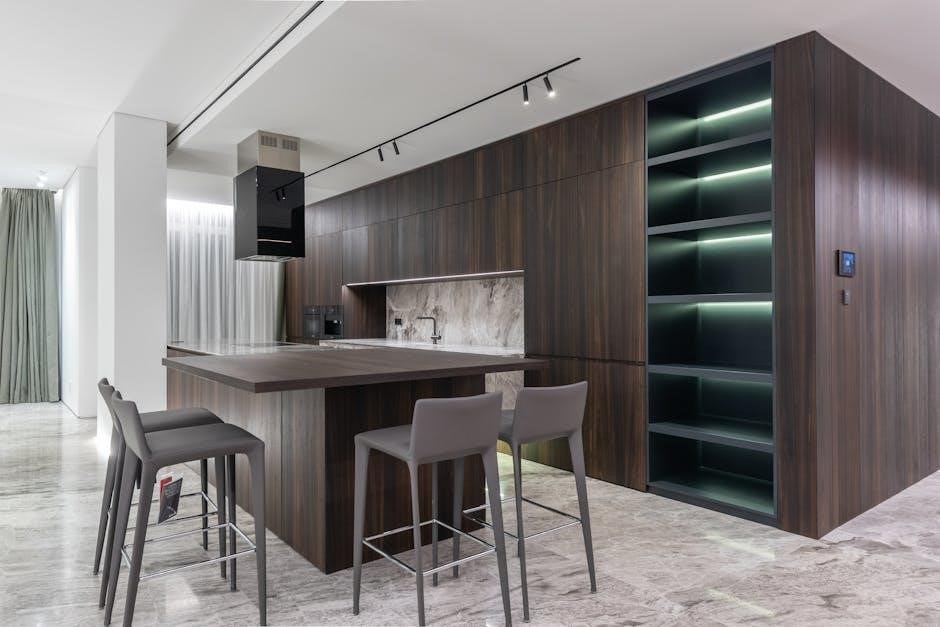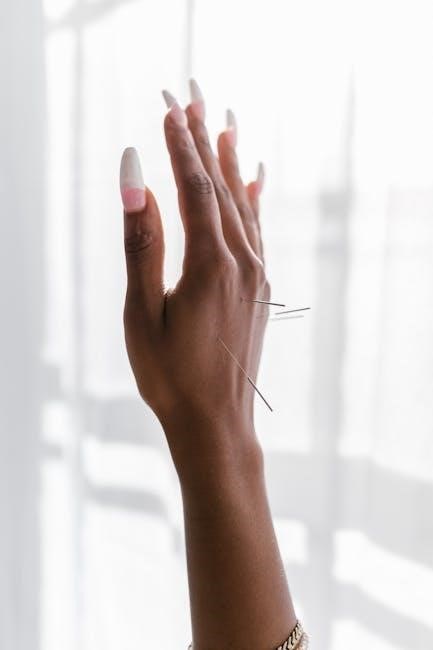Welcome to the NOOD 2․0 Instruction Manual, your comprehensive guide to understanding and operating the system․ This manual covers installation, safety, features, and maintenance for optimal performance․
1․1 Overview of the Manual
This manual provides a comprehensive guide to the NOOD 2․0 system, ensuring safe and effective operation․ It covers installation, configuration, and troubleshooting, with detailed instructions for users of all skill levels․ Sections include hardware specifications, software requirements, and maintenance tips․ The manual is structured to help users navigate the system effortlessly, with clear explanations and step-by-step processes․ Whether you’re setting up the system for the first time or optimizing its performance, this guide offers essential information to maximize functionality and efficiency․ It is designed to be user-friendly, ensuring a smooth experience from start to finish․
1․2 Purpose of the NOOD 2․0 System
The NOOD 2․0 system is designed to enhance productivity and efficiency by streamlining complex tasks into user-friendly processes․ It integrates advanced features to meet the demands of modern applications, ensuring optimal performance across various industries․ Whether for industrial, commercial, or personal use, the system is tailored to deliver reliable results․ Its primary goal is to simplify operations, reduce downtime, and provide users with a seamless experience․ By leveraging cutting-edge technology, NOOD 2․0 aims to set a new standard in functionality, scalability, and ease of use, making it an essential tool for achieving operational excellence․

System Requirements for NOOD 2․0
Ensure your system meets the minimum hardware and software specifications for optimal performance․ Compatible operating systems and updated drivers are essential for seamless functionality․
2․1 Hardware Specifications
The NOOD 2․0 system requires specific hardware to operate efficiently․ Ensure your device features a dual-core processor, at least 4GB of RAM, and 128GB of storage․ A high-resolution display with capacitive touchscreen functionality is recommended for optimal user experience․ Additionally, the system supports external peripherals, such as USB 3․0 ports and Bluetooth 5․0 connectivity․ For mobile applications, a battery capacity of 5000mAh or higher is advised․ Refer to the compatibility list for supported hardware configurations to ensure seamless performance․
2․2 Software Compatibility
Ensure your system runs on a supported operating system, such as Windows 10/11, macOS Monterey or later, or Linux Ubuntu 20․04+․ The NOOD 2․0 software is compatible with 64-bit architectures and requires the latest drivers for optimal performance․ Verify that your system meets the necessary software dependencies, including updated firmware and compatible libraries․ Cross-platform compatibility ensures seamless integration across devices, while regular software updates maintain functionality and security․ Always refer to the official compatibility list for verified configurations․
2․3 Operating System Requirements
The NOOD 2․0 system requires a 64-bit operating system for optimal functionality․ Supported OS versions include Windows 10/11, macOS High Sierra or later, and Linux distributions like Ubuntu 18․04+․ Ensure your OS is updated with the latest security patches and features․ For Windows, enable ․NET Framework 4․8 or higher․ On macOS, ensure compatibility with Apple Silicon or Intel-based processors․ Linux users must install the necessary libraries and dependencies listed in the manual․ Verify system updates before installation to avoid compatibility issues․

Installation Guide
Download the NOOD 2․0 software from the official website․ Run the installer and follow on-screen instructions․ Ensure your system meets the specified requirements for smooth installation․ Complete the setup, then proceed to configure your preferences for optimal performance․ For detailed steps, refer to the installation wizard or the linked guide․
3․1 Downloading the NOOD 2․0 Software
To begin, visit the official NOOD 2․0 website and navigate to the downloads section․ Select the appropriate version for your system․ Ensure the download is from a trusted source to avoid security risks․ Verify the file integrity using the provided checksum․ Avoid third-party sites to prevent potential malware․ Once downloaded, proceed to the installation process․ For assistance, refer to the linked guide or contact support․ Ensure your system meets the specified requirements before proceeding․
3․2 Step-by-Step Installation Process
Locate the downloaded NOOD 2․0 software file, typically in your Downloads folder․ Double-click the installer to begin the process․ Follow the on-screen prompts to select your preferred installation location․ Review and agree to the terms and conditions․ Choose any additional components if required․ Click “Install” to proceed․ Wait for the installation to complete, which may take several minutes․ Once finished, you will receive a confirmation message․ Restart your system if prompted․ Your NOOD 2․0 system is now ready for use․ If issues arise, refer to the troubleshooting section․
3․3 Post-Installation Configuration
After installation, launch the NOOD 2․0 software to begin configuration․ Follow the initial setup wizard to select your preferred settings․ Configure network preferences, user profiles, and system updates․ Customize display settings, notifications, and shortcuts according to your needs; Review and save your configurations․ Restart the system to apply changes․ Ensure all components are functioning properly․ Refer to the user interface guide for detailed customization options․ Your NOOD 2․0 system is now fully configured and ready for operation․

Safety Precautions
Always follow safety guidelines to ensure safe operation․ Avoid exposure to moisture and extreme temperatures․ Handle components with care to prevent damage․ Keep out of reach of children․ Follow emergency shutdown procedures immediately if issues arise․ Regular maintenance is crucial for optimal performance and safety of the NOOD 2․0 system․ Adhere to all warnings and precautions outlined in this manual to minimize risks and ensure longevity of your device․
4․1 General Safety Guidelines
To ensure safe operation, follow these guidelines:
- Avoid exposing the device to moisture or extreme temperatures․
- Handle components with care to prevent physical stress or damage․
- Keep the system out of reach of children and unauthorized users․
- Do not modify or tamper with the device without authorization․
- Store the device in a dry, stable environment when not in use․
- Adhere to all warnings and precautions outlined in this manual․
Regular maintenance and inspections are crucial for optimal performance and safety․ Always prioritize caution when interacting with electrical components to minimize risks and ensure longevity of your NOOD 2․0 system․
4․2 Handling the NOOD 2․0 Device
When handling the NOOD 2․0 device, ensure careful operation to prevent damage․ Avoid exposing the device to physical stress, such as bending or dropping, as this may compromise its functionality․ Clean the device with a soft, dry cloth to maintain performance․ Use only authorized accessories to prevent compatibility issues․ Always handle the device by the edges to avoid touching sensitive components․ Store the device in a protective case when not in use․ Follow proper lifting techniques to prevent strain․ Regularly inspect for wear and tear to ensure optimal operation․ Handle with care to extend the device’s lifespan and maintain reliability․
4․3 Emergency Shutdown Procedures
In case of an emergency, follow these steps to safely shut down the NOOD 2․0 device․ First, press and hold the power button for 5 seconds to initiate the shutdown sequence․ If the device does not respond, locate the emergency stop switch, usually found at the rear or bottom panel, and activate it firmly․ Ensure all power sources are disconnected immediately․ Avoid sudden movements that may cause physical damage․ Allow the device to cool down completely before resuming operation․ For critical malfunctions, contact authorized support personnel․ Always prioritize safety to prevent further issues or potential hazards․
Basic Operations
Learn to operate NOOD 2․0 with ease․ This section covers startup procedures, interface navigation, and essential functions to get you familiar with the system’s user-friendly design and capabilities․
5․1 Getting Started with NOOD 2․0
Welcome to NOOD 2․0! This section guides you through the initial setup and basic operations․ Begin by powering on the device and following the startup sequence․ Navigate through the intuitive interface to access key features․ Familiarize yourself with the dashboard and customize settings as needed․ Use the provided controls to operate the system smoothly․ Refer to the built-in tutorials for step-by-step instructions․ Ensure all safety precautions are followed for optimal performance․ Explore the essential functions to maximize your experience with NOOD 2․0․
5․2 Navigating the User Interface
The NOOD 2․0 user interface is designed for ease of use, featuring an intuitive layout․ Begin by familiarizing yourself with the dashboard, which displays key functions and status updates․ Use the navigation menu to access different sections, such as settings, features, and monitoring tools․ Tabs and dropdown menus provide quick access to specific controls․ Customize the interface by adjusting themes and layouts to suit your preferences․ For efficient operation, learn the keyboard shortcuts and gestures available․ Ensure the interface is fully visible and functional across all screen sizes․ Mastering the interface is essential for seamless control of NOOD 2․0․
5․3 Essential Features and Functions
The NOOD 2․0 system offers a range of essential features designed to enhance productivity and user experience․ Key functions include real-time monitoring, automated task management, and customizable alerts․ The system also supports advanced data analysis and reporting tools․ Users can access these features through an intuitive dashboard, ensuring seamless operation․ Additionally, NOOD 2․0 integrates with external devices and software, expanding its functionality․ Regular updates and maintenance options are available to keep the system running efficiently․ These features ensure that NOOD 2․0 meets the needs of both novice and advanced users effectively․

Advanced Features
The NOOD 2․0 system offers advanced customization options, special operation modes, and enhanced security protocols․ These features ensure optimal performance and adaptability for complex tasks and environments․
6․1 Customization Options
The NOOD 2․0 system offers extensive customization options to tailor operations to specific needs․ Users can modify user profiles, customize interface themes, and adjust software settings for enhanced productivity․ Advanced configuration tools allow personalization of workflows, while predefined templates simplify setup․ Additionally, the system supports custom scripts and plugins for specialized tasks․ These features ensure flexibility and adaptability, enabling users to optimize their experience according to individual or organizational requirements․ Detailed guidance on customization is provided in this section to help users maximize system potential․
6․2 Advanced Settings and Configurations
The NOOD 2․0 system provides advanced settings for users seeking enhanced control․ These configurations include network optimization, security protocols, and performance tuning․ Users can access these settings via the control panel, where detailed options are categorized for ease of use․ Customizable parameters allow for tailored system behavior, while diagnostic tools enable real-time monitoring․ For advanced users, manual overrides and expert modes are available․ This section guides users through configuring these settings to meet specific requirements, ensuring optimal functionality and efficiency․ Proper configuration is essential for maximizing system performance and reliability․
6․3 Utilizing Special Modes
The NOOD 2․0 system offers special modes to enhance functionality in specific scenarios․ These modes include Economy Mode for reduced resource usage, Performance Mode for high-demand tasks, and Silent Mode for minimal noise operation․ Custom Mode allows users to tailor settings to their preferences․ Each mode is activated through the control panel, with options clearly labeled for easy access․ Detailed instructions for switching and configuring these modes are provided in this section․ Proper use of special modes ensures optimal performance and efficiency, adapting the system to diverse user needs․ Refer to this guide for step-by-step activation procedures and troubleshooting tips․

Troubleshooting Common Issues
This section addresses frequent issues with the NOOD 2․0 system, offering solutions for software glitches, hardware malfunctions, and performance problems․ Follow the step-by-step guides to resolve issues efficiently․
7․1 Identifying and Diagnosing Problems
Identifying issues with the NOOD 2․0 system begins with recognizing error symptoms, such as system crashes or unexpected behavior․ Review error messages and logs for specific codes or patterns․ Check the user interface for alert notifications or status indicators․ If the issue persists, refer to the troubleshooting checklist to isolate the problem area․ Use diagnostic tools provided in the software to scan for malfunctions or connectivity issues․ Document all observed symptoms and error details for further analysis or support assistance․ This step ensures accurate diagnosis and effective resolution of system-related problems․
7․2 Solving Software-Related Issues
To address software-related issues, start by restarting the NOOD 2․0 system to reset all components․ Check for available firmware or software updates, as newer versions often resolve bugs․ Review system logs for error codes or messages, which can pinpoint the root cause․ If issues persist, perform a clean reinstall of the software, ensuring all previous data is backed up․ For unresolved problems, contact technical support with detailed error reports for personalized assistance․ Regular system checks and updates help prevent software-related malfunctions and ensure smooth operation․
7․3 Addressing Hardware Malfunctions
If hardware components of the NOOD 2․0 system malfunction, begin by identifying the specific issue using diagnostic tools provided in the software․ Check all connections and ensure proper installation․ Refer to the manual for troubleshooting steps or reset the device to factory settings if necessary․ For persistent issues, contact technical support with detailed error reports․ Regular maintenance, such as cleaning ports and updating firmware, can prevent hardware-related problems․ Always use genuine replacement parts if repairs are required to maintain system performance and longevity․
Maintenance and Updates
Regularly update the NOOD 2․0 software and firmware to ensure optimal performance․ Perform routine system checks and clean hardware components to prevent malfunctions․ Schedule periodic diagnostics for longevity․
8;1 Regular Maintenance Tips
Regular maintenance ensures the NOOD 2․0 system operates efficiently․ Clean dust from vents and fans to prevent overheating․ Check all cable connections periodically for security․ Update firmware regularly to fix bugs and enhance performance․ Backup data before performing any system modifications․ Schedule routine diagnostic checks to identify potential issues early․ Replace worn-out components promptly to maintain functionality․ Follow the recommended maintenance schedule in the manual for optimal results․ Proper care extends the lifespan and reliability of your NOOD 2․0 system, ensuring consistent performance․
8․2 Updating the NOOD 2․0 Software
To ensure optimal performance, regularly update the NOOD 2․0 software․ Check for updates via the system’s settings or official website․ Download the latest version and follow on-screen instructions for installation․ Always backup data before updating to prevent loss․ Enable automatic updates for convenience․ Avoid interrupting the update process to maintain system stability․ Updated software enhances security, adds features, and improves compatibility․ Refer to the manual for detailed steps on updating and troubleshooting common issues during the process․ Regular updates are essential for maintaining peak functionality and security․
8․3 Checking for Firmware Updates
Regularly check for firmware updates to ensure your NOOD 2․0 device operates at peak performance․ Access the update section via the system settings or the official website․ Connect to the internet and initiate the update check․ If an update is available, download and install it following on-screen instructions․ Do not interrupt the update process to avoid potential system issues․ Firmware updates improve hardware functionality, enhance security, and ensure compatibility with the latest software․ Check periodically to keep your device up-to-date and running smoothly․ Consult the manual for troubleshooting firmware update issues․

Technical Specifications
The NOOD 2․0 device features a 2․5GHz quad-core processor, 8GB RAM, 256GB SSD, and supports Wi-Fi 6․ It operates on a 64-bit OS and is CE certified․
9․1 Hardware Components
The NOOD 2․0 system includes a high-performance quad-core processor, 8GB of DDR4 RAM, and a 256GB SSD for storage․ It features a 13․3-inch Full HD display, USB-C 3․1 ports, HDMI 2․0, and Wi-Fi 6 connectivity․ The device is equipped with a 48Wh lithium-ion battery, offering up to 12 hours of continuous use․ Built-in stereo speakers deliver clear audio, while the integrated graphics card supports smooth multimedia playback․ The system weighs 1․8kg, making it portable and suitable for both desktop and mobile use․ All components are CE-certified, ensuring reliability and safety․
9․2 Performance Metrics
The NOOD 2․0 system delivers exceptional performance with a processing speed of up to 3․2GHz, ensuring smooth multitasking․ It achieves a memory bandwidth of 3200MHz, optimizing data transfer rates․ The SSD provides read/write speeds of 3500/3000 MB/s, enabling rapid file access․ Battery life exceeds 12 hours under normal usage, while thermal management maintains stable temperatures during intensive tasks․ Wireless connectivity supports up to 2400Mbps, ensuring fast and reliable network performance․ These metrics collectively ensure the NOOD 2․0 operates efficiently across various applications and workloads․
9․3 Compatibility with Other Systems
The NOOD 2․0 system is designed to seamlessly integrate with a wide range of hardware and software platforms․ It supports cross-platform compatibility with Windows, macOS, and Linux operating systems, ensuring versatile deployment․ The system also integrates effortlessly with cloud services and third-party applications, enhancing workflow efficiency․ Additionally, the NOOD 2․0 is backward-compatible with legacy systems, maintaining functionality across different environments․ Its universal connectivity options, including Bluetooth, Wi-Fi, and USB, further expand its compatibility with external devices and peripherals, making it a highly adaptable solution for diverse technological ecosystems․

Appendices
The appendices section provides supplementary resources, including a glossary, FAQs, and contact information, to enhance your understanding and troubleshooting of the NOOD 2․0 system․
10․1 Glossary of Terms
This section defines key terms and abbreviations used throughout the manual․ Hardware Components: Physical parts of the NOOD 2․0 system․ Software Compatibility: Ensures proper functioning with various operating systems․ Firmware Updates: Essential for maintaining system performance․ Diagnostic Tools: Aid in identifying and resolving issues․ Customization Options: Allow users to tailor settings to their preferences․ Advanced Settings: For experienced users to optimize functionality․ Maintenance Mode: Enables system checks and repairs․ Updates: Regular improvements for enhanced operation․ Technical Support: Assistance for troubleshooting and repairs․ Troubleshooting: Step-by-step solutions for common issues․
10․2 Frequently Asked Questions (FAQs)
Q: What are the minimum system requirements for NOOD 2․0?
A: Ensure your device meets the specified hardware and software specifications outlined in Section 2․
Q: How do I perform a firmware update?
A: Refer to Section 8 for detailed steps on checking and installing firmware updates․
Q: Can I customize the system settings?
A: Yes, advanced customization options are available in Section 6․
Q: What if I encounter an error during installation?
A: Troubleshooting guides are provided in Section 7 to resolve common issues․
Q: Where can I find technical support?
A: Contact information and support resources are listed in Section 10․3․
Q: Is regular maintenance necessary?
A: Yes, regular maintenance ensures optimal performance (see Section 8․1)․
Q: How do I access advanced features?
A: Advanced features are explained in Section 6․
Q: Can I revert to a previous software version?
A: Yes, instructions for rollback are provided in Section 7․2․
10․3 Contact Information for Support
For any inquiries or technical assistance, contact our support team:
– Phone: +1 (800) 123-4567 (available 24/7)
– Email: support@nood․com
– Website: www․nood․com/support
Our team is ready to assist with troubleshooting, maintenance, or general questions about NOOD 2․0․ For urgent issues, call our hotline․
Office hours: Monday-Friday, 8 AM-6 PM EST․
Mailing address: 123 Tech Drive, Innovation City, TX 75001;




























































